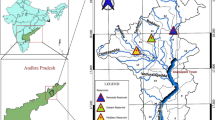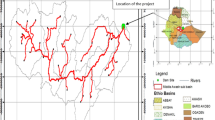Abstract
Hill torrents cause a lot of environmental and property damage in Pakistan every year. Proper assessment of direct runoff in the form of hill torrents is essential for protection of environment, property, and human life. In this paper, direct surface runoff hydrograph (DSRH) was derived for a large catchment using the geomorphologic instantaneous unit hydrograph concept. The catchment with hill torrent flows in semi-arid region of Pakistan was selected for this study. It was divided into series of linear cascades and hydrologic parameters required for Nash’s conceptual model, and were estimated using geomorphology of the basin. Geomorphologic parameters were derived from satellite images of the basin and ERDAS and ArcGIS were used for data processing. Computer program was developed to systematically estimate the dynamic velocity, its related parameters by optimization and thereby to simulate the DSRH. The data regarding rainfall–runoff and satellite images were collected from Punjab Irrigation and Power Department, Pakistan. Model calibration and validation was made for 15 rainfall–runoff events. Ten events were used for calibration and five for validation. Model efficiency was found to be more than 90% and root mean square error to be about 5%. Impact of variation in model parameters (shape parameter and storage coefficient) on DSRH was investigated. For shape parameter, the number of linear cascades varied from 1 to 3 and it was found that the shaper parameter value of 3 produced the best DSRH. Various values of storage coefficient were used and it was observed that the value determined from geomorphology and the dynamic velocity produced the best results.







Similar content being viewed by others
References
Ahmad, M. M. (2009). Investigation and application of new techniques in determination of runoff for various conditions of humid and arid catchments. PhD thesis, University of Engineering and Technology, Taxila, Pakistan.
Ahmad, M. M., Ghumman, A. R., & Ahmad, S. (2009). Estimation of Clark's instantaneous unit hydrograph parameters and development of direct surface runoff hydrograph. Journal of Water Resources Management, 23, 2417–2435.
Ahmad, M. M., Ghumman, A. R., Ahmad, S., & Hashmi, H. N. (2010). Estimation of a unique pair of Nash model parameters: An optimization approach. Journal of Water Resources Management, 24(12), 2971–2989.
Bahremand, A., & De Smedt, F. (2008). Distributed hydrological modeling and sensitivity analysis in Torysa Watershed, Slovakia. Water Resources Management, 22(3), 393–408.
Bahremand, A., & De Smedt, F. (2010). Predictive analysis and simulation uncertainty of a distributed hydrological model. Water Resources Management, 24(12), 2869–2880.
Bekele, E. G., & Knapp, H. V. (2010). Watershed modeling to assessing impacts of potential climate change on water supply availability. Water Resources Management, 24(13), 3299–3320.
Bhaskar, N. R., Parida, B. P., & Nayak, A. T. (1997). Flood estimation for ungauged catchments using the GIUH. Journal of Hydrology for Engineering ASCE, 123(4), 228–238.
Cao, S., Lee, K. T., Ho, J., Liu, X., Huang, E., & Yang, K. (2010). Analysis of runoff in ungauged mountain watersheds in Sichuan, China using kinematic-wave-based GIUH model. Journal of Mountain Science, 7(2), 157–166.
Coskun, H. G., Alganci, U., Eris, E., Agıralioglu, N., Cigizoglu, H. K., Yilmaz, L., et al. (2010). Remote sensing and GIS innovation with hydrologic modelling for hydroelectric power plant (HPP) in poorly gauged basins. Journal of Water Resources Management, 24(14), 3757–3772.
Deckers, D. L. E. H., Booij, M. J., Rientjes, T. H. M., & Krol, M. S. (2010). Catchment variability and parameter estimation in multi-objective regionalisation of a rainfall–runoff model. Journal of Water Resources Management, 24(14), 3961–3985.
Gill, P. E., Murray, W., & Wright, M. H. (1981). Practical optimization. London: Academic.
Horton, R. E. (1945). Erosional development of streams and their drainage basins; hydrophysical approach to quantitayive morphology. Bulletin Geological Society of America, 56, 275–370.
Jain, K. S., Singh, V. P., & Bhunya, P. K. (2006). Development of optimal and physically realizable unit hydrograph. Journal of Hydrology for Engineering ASCE, 11(6), 612–616.
Jena, S. K., & Tiwari, K. N. (2006). Modelling synthetic unit hydrograph parameter with geomorphologic parameters of watershed. Journal of Hydrology, 319, 1–14.
Kumar, R., Chaterrjee, C., Singh, R. D., Lohani, A. K., & Kumar, S. (2004). GIUH based Clark and Nash models for runoff estimation for an ungauged basin and their uncertainty analysis. International Journal of River Management, 2(4), 281–290.
Linsley, R. K., Kohler, M. A., & Paulhus, J. L. H. (1982). Hydrology for engineers (3rd ed.). New York: McGraw-Hill Book Co., Inc.
Nash, J. E. (1957). The form of instantaneous unit hydrograph. International Association of Scienific Hydrologists. Publication No. 51, 546–557, IAHS, Gentbrugge, Belgium.
Nash, J. E. (1960). A unit hydrograph study with particular reference to British catchments. Proceeding of International Civil Engineering, 17, 249–282.
Nash, J. E., & Sutcliffe, J. V. (1970). River flow forecasting through conceptual models, Part-I: A discussion of principles. Journal for Hydrology, 10(3), 282–290. Proc.-Intl. Civ. Eng., 17, 249–282.
Nguyen, H. Q. (2008). Utilization of SRTM data for flood protection based on GIUH approach. Review Geographica Acadêmica, 2(2), 14–25. viii.2008.
Oosterbaan R. (2010). Spate Irrigation: Water harvesting and agricultural land development options in the NWFR of Pakistan, Proceeding of International Policy Workshop “Water Management and Land Rehabilitation, NW Frontier Region, Pakistan”, Islamabad, December 6–8, 2010
Ponce, V. M. (1989). Engineering hydrology principles and practices. NJ: Prin. Hall Inc.
Rai, R. K., Upadhyay, A., Sarkar, S., Upadhyay, A. M., & Singh, V. P. (2009). GIUH based transfer function for Gomti River Basin of India. Journal of Spatial Hydrology, 9(2), 24–50. Fall 2009.
Ramirez, J. A. (2000). Prediction and modelling of flood hydrology and hydraulics, Chapter 11 of inland flood hazards: Human, riparian and aquatic communities Eds. Ellen Wohl; Cambridge University Press, 2000.
Rodriguez-Iturbe, I., Devoto, G., & Valdes, J. B. (1979). Discharge response analysis and hydrologic similarity: The interrelation between the geomorphologic IUH and the storm characteristics. Water Resources Research, 15(6), 1435–1444.
Rosso, R. (1984). Nash model relation to Horton order ratios. Water Resources Research, 20(7), 914–920.
Sahoo, B., Chandranath, C., Narendra, S. R., Singh, R., & And, K. R. (2006). Flood estimation by GIUH-based Clark and Nash models. Journal of Hydrology for Enginering ASCE, 11(6), 515–525.
Sarangi, A., Madramootoo, C. A., Enright, P., & Prasher, S. O. (2007). Evaluation of three unit hydrograph models to predict the surface runoff from a Canadian watershed. Journal of Water Resources Management, 21(7), 1127–1143.
Singh, S. K. (2004). Simplified use of gamma-distribution/Nash model for runoff modeling. Journal of Hydrology for Engineering ASCE, 9(3), 240–243.
Singh, P. K., Bhunya, P. K., Mishra, S. K., & Chaube, U. C. (2007). An extended hybrid model for synthetic unit hydrograph derivation. Journal of Hydrology, 336, 347–360.
William H. P., Brain P. F., Saul A. T., & Wiliam T. V., (1986). Minimization or maximization of functions. Numerical Recipes, The Art of Scientific Computing. p. 274–334.
Zelazinski J. (1986). Application of the geomorphological instantaneous unit hydrograph theory to development of forecasting models in Poland. Hydrol. Sci. Journal-des Sciences Hydrogiques, 31, 2, 6/1986.
Author information
Authors and Affiliations
Corresponding author
Rights and permissions
About this article
Cite this article
Ghumman, A.R., Ahmad, M.M., Hashmi, H.N. et al. Development of geomorphologic instantaneous unit hydrograph for a large watershed. Environ Monit Assess 184, 3153–3163 (2012). https://doi.org/10.1007/s10661-011-2179-3
Received:
Accepted:
Published:
Issue Date:
DOI: https://doi.org/10.1007/s10661-011-2179-3




